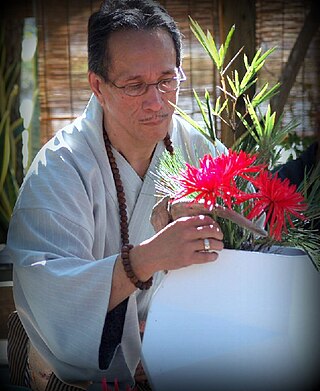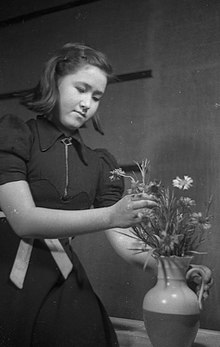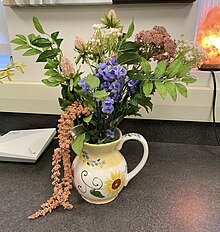
Floristry is the production, commerce, and trade in flowers. It encompasses flower care and handling, floral design and arrangement, merchandising, production, display and flower delivery. Wholesale florists sell bulk flowers and related supplies to professionals in the trade. Retail florists offer fresh flowers and related products and services to consumers. The first flower shop in the United States opened prior to 1851.

A corsage is a small bouquet of flowers worn on a woman's dress or around her wrist for a formal occasion. They are typically given to her by her date. Today, corsages are most commonly seen at homecomings, proms, and similar formal events.

Artificial plants are imitations of natural plants used for commercial or residential decoration. They are sometimes made for scientific purposes. Artificial plants vary widely from mass-produced varieties that are distinguishable from real plants by casual observation to highly detailed botanical or artistic specimens.
Visual design elements and principles describe fundamental ideas about the practice of visual design.
Flower delivery is a service in floristry. In many cases it is conducted through websites which allow consumers to browse online catalogues of flowers. They are often delivered to a third party, the recipient of the gift. Historically, these were coordinated through telegraphs and later telephones before the advent of the World Wide Web.
Bouquets to Art is an annual floral exhibition hosted by the De Young Museum of Fine Arts Museums of San Francisco. Florists, designers and garden clubs are invited to present floral interpretations of works in the museum's permanent collections, and the floral displays are presented in juxtaposition with the works that inspired them.
Smithers-Oasis is a company specializing in floristry products headquartered in Kent, Ohio, United States. The company created water-absorbing foam in 1954.

The floral industry is focused on the production, distribution and sale of flowers for human enjoyment. The floral industry began in the Golden Century of the Netherlands, where flowers were grown on a large scale on vast estates. The industry continues to diversify from the production of cut flowers to the production and sale of plants and flowers in many different forms. The global floral industry market size is estimated to be worth US$ 50040 million in 2022 and is forecast to increase to US$ 58030 million by 2028 with a compound annual growth rate of 2.5% during the review period.

The White House chief floral designer is responsible for the planning, design, arrangement, and placement of all floral decorations for the first family, their private entertaining, and official state functions at the White House, the official residence and principal workplace of the president of the United States. The current chief floral designer is Hedieh Ghaffarian.

Paper models, also called card models or papercraft, are models constructed mainly from sheets of heavy paper, paperboard, card stock, or foam.
The American Institute of Floral Designers (AIFD), established in 1965, is the oldest and largest non-profit organization dedicated to recognizing and promoting the art of floral design as a professional career. Its more than 1200 members engage in a variety of professional programs and activities through a network of six (6) regional chapters throughout the United States and Canada.

The history of flower arrangement dates back to ancient Egyptian times.

Nichlas Sorren Osman Vilsmark is a Danish florist and teacher, living and working in London, United Kingdom. He has worked on many major events, and was Head Florist for the wedding of the Danish Crown Prince in 2004.

The Texas State Florists' Association (TSFA) was founded in 1914 and is headquartered in Austin, Texas. Since its inception, the TSFA has grown into a professional trade association that covers many branches of the floral industry. Its membership base includes a diverse assortment of people in the floral industry, and it is involved in professional services and marketing in support of floral interests, state legislation, and the provision of educational opportunities. It represents the Texas floral industry, and has members in ten additional states. The organization hosts an annual convention, the first of which occurred in 1914. The TSFA sponsors the Texas Certified Florists Program, and publishes a monthly magazine named TEXAS in Bloom.

Cut flowers are flowers and flower buds that have been cut from the plant bearing it. It is removed from the plant for decorative use. Cut greens are leaves with or without stems added to the cut flowers for contrast and design purposes. These displays improve the quality of the human environment.
Floral Jamming is a floral design activity originating from Hong Kong, where participants design their own original sculpture with floral materials. The floral designer provides all materials required for the floral display including flowers and foliage. Participants select the materials to create their own floral creation within a set time.

Banmi Shōfū-ryū (晩美生風流) is a school of Ikebana, an ancient Japanese art form that involves arranging flowers for spiritual purposes. Ikebana accompanied Buddhism's arrival in Japan in the 6th century and evolved from a Buddhist ritual. This ritual, which started in India, consisted of throwing “floral offerings” to the spirits of those who had passed. By the 10th century, containers were used for the floral offerings, slowly representing the development of Ikebana. Kado, which means “way of the flower,” is used in Ikebana practice and began to spread into more of an aesthetic than a spiritual representation during this time. By the 15th century, Ikebana embodied what it is known for today, an art form with a spiritual foundation. Ikebana is a way to connect with the flowers through active meditation, producing calmness and concentration for those who engage in this complex and expressional art. Ikebana has also been shown to have calming physiological effects on both creators and viewers of the art.
The Society of American Florists (SAF) is a national US Trade Association representing floristry in the United States (US). Retailers, growers, wholesalers, importers, manufacturers, suppliers, educators, students and allied organizations are members.
Ming Veevers-Carter is a florist who represented New Covent Garden Market at the 2016 Chelsea Flower Show. She designed a floral portrait of the Queen which was the centrepiece of 10,000 flowers and foliage stems in a display called "Behind Every Great Florist". Photographs of this with the Queen appeared in the press, and the display won a gold medal and the Royal Horticultural Society's New Design award.
Patricia Easterbrook Roberts was an Australian-born floral designer, author, and landscape designer who worked in Australia, England and the United States.





















